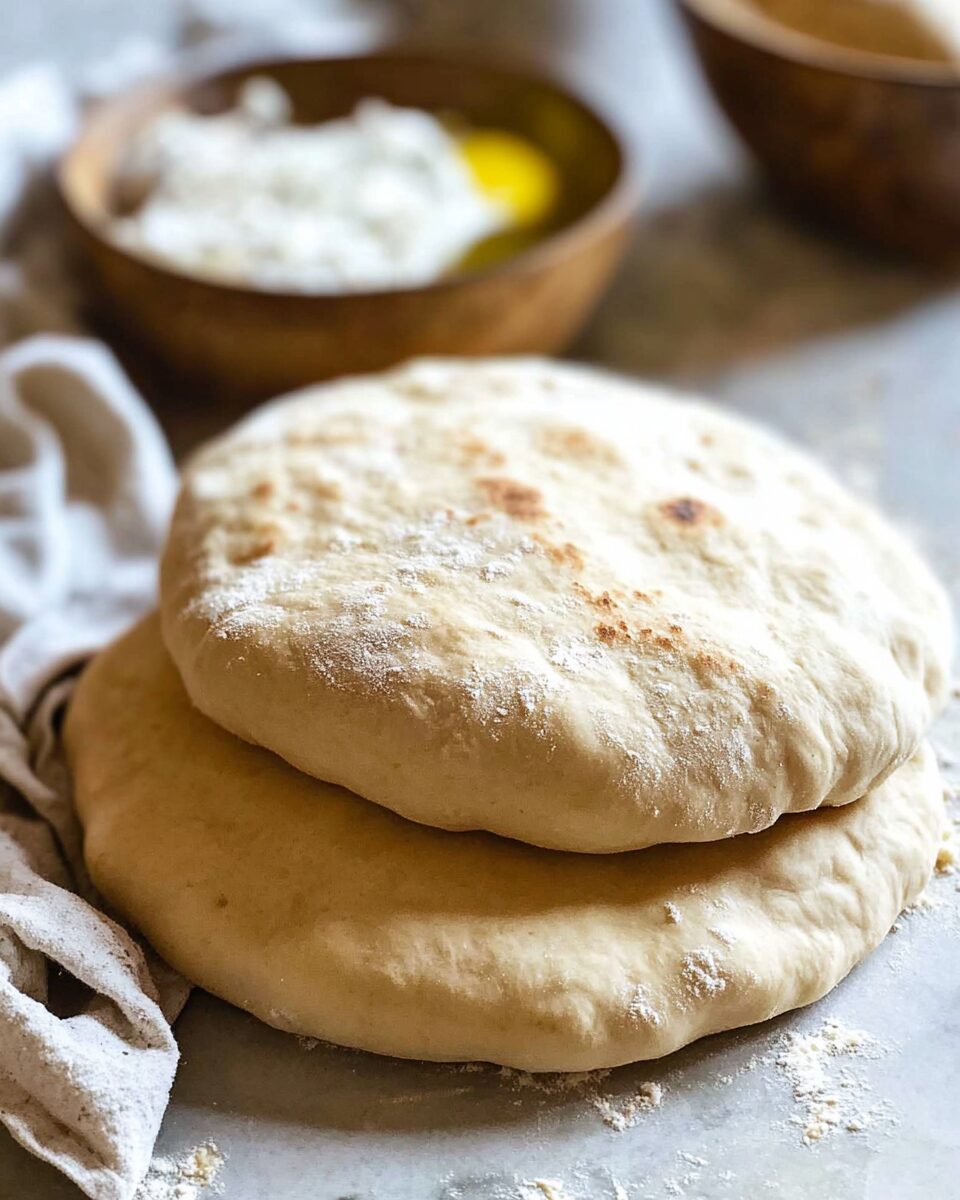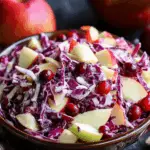Nothing beats the warm, pillowy texture of freshly made pita bread. When cooked right, the dough puffs beautifully to create a perfect pocket, ideal for stuffing with all your favorite Mediterranean-inspired fillings. The subtle golden spots and soft crumb make it not only delicious but visually inviting.
This easy homemade pita recipe is incredibly versatile and a fantastic way to elevate your meals. Whether you use it to scoop up dips like hummus, stuff it with falafel and veggies, or serve alongside grilled meats, this bread adds that authentic homemade touch. Plus, it’s simple enough for even beginner bakers to master and enjoy the magic of baking from scratch.
Full recipe:
Ingredients:
-
3 cups all-purpose flour
-
1 ½ teaspoons salt
-
1 tablespoon sugar
-
1 packet (2 ¼ teaspoons) active dry yeast
-
1 ¼ cups warm water (about 110°F/43°C)
-
2 tablespoons olive oil
Directions:
-
In a large mixing bowl, combine warm water, sugar, and yeast. Stir gently and let it sit for 5-10 minutes until foamy.
-
Add flour, salt, and olive oil to the yeast mixture. Stir to combine and then knead the dough on a lightly floured surface for about 8-10 minutes until smooth and elastic.
-
Place the dough in a lightly oiled bowl, cover with a clean towel or plastic wrap, and let it rise in a warm place for about 1 to 1 ½ hours or until doubled in size.
-
Punch down the dough and divide it into 8 equal pieces. Roll each piece into a ball, then flatten into 6-7 inch circles.
-
Cover the circles with a damp towel and let rest for 20 minutes to rise slightly.
-
Heat a heavy skillet or cast iron pan over medium-high heat.
-
Cook each pita circle for 1-2 minutes on each side, or until puffed and golden brown spots appear. The pita should puff up, creating a pocket inside.
-
Remove from heat and wrap cooked pitas in a clean kitchen towel to keep soft. Serve warm or at room temperature.
Prep Time: 20 minutes | Cooking Time: 15 minutes | Total Time: 1 hour 45 minutes
Kcal: 150 kcal per pita | Servings: 8 pitas
The History and Cultural Significance of Pita Bread
Pita bread has ancient origins, dating back thousands of years, with evidence of flatbreads baked in the Middle East as early as 2500 BC. Its simple ingredients—flour, water, yeast, salt, and olive oil—reflect the resourcefulness of early civilizations. Pita bread is a fundamental part of daily meals in countries such as Lebanon, Israel, Greece, Turkey, and Egypt, where it accompanies everything from dips like hummus and baba ganoush to grilled meats, salads, and stews.
This bread has transcended cultural boundaries and become a popular item in many global cuisines due to its adaptability. The word “pita” itself originates from Greek, meaning “pie” or “bread,” illustrating its deep roots in Mediterranean food traditions.
What Makes Pita Bread Unique?
What distinguishes pita bread from other types of bread is the process that creates its pocket. When the dough is rolled into thin rounds and cooked at high heat, steam forms inside the dough, causing it to puff up. This puffing creates a hollow space in the center, which cools to form the famous pocket. This characteristic makes pita bread highly versatile, perfect for stuffing with savory or sweet fillings.
Another notable quality of pita bread is its soft and chewy texture, which balances beautifully with its slightly crisp, golden exterior. Because it’s a flatbread, it cooks quickly and pairs well with a wide range of dishes, making it a perfect bread choice for busy households and meal prep.
Why Make Pita Bread at Home?
While pita bread is widely available in stores, homemade pita offers several advantages that store-bought versions simply cannot match. Firstly, homemade pita is free from preservatives, artificial additives, or excess salt and sugar often found in commercial products. This ensures a fresher, cleaner taste that enhances any meal.
Moreover, baking your own pita allows you to control the texture and thickness to your preference. You can make them thinner for crispier results or thicker for a more substantial pocket. You can also experiment with whole wheat or gluten-free flour blends to suit dietary needs.
Making pita bread at home can also be a rewarding and enjoyable kitchen project. The dough is simple to make and requires minimal ingredients, and the process of watching the bread puff up on the stove or oven is both fascinating and satisfying.
Tips for Perfect Pita Bread
Achieving that perfect puff and pocket can sometimes be tricky for beginners, but a few key tips make all the difference. First, the dough must be kneaded well to develop gluten, which provides elasticity and strength. This elasticity helps trap steam during cooking and allows the bread to puff evenly.
Second, the cooking surface should be very hot before placing the dough rounds on it. Whether you use a cast iron skillet, griddle, or baking stone, a high temperature ensures rapid steam formation and puffing.
Resting the dough after shaping is also important. Letting the rolled-out circles rest for about 20 minutes before cooking helps relax the gluten, making the dough easier to puff and less likely to tear.
Finally, immediately wrapping the cooked pitas in a clean towel keeps them soft and pliable by trapping moisture inside.
Serving Suggestions and Culinary Uses
Pita bread is one of the most versatile breads in the culinary world. Its pocket can be filled with grilled meats like chicken shawarma or lamb kebabs, falafel, fresh vegetables, and a variety of sauces such as tzatziki or tahini. It is equally delicious served alongside dips like hummus, baba ganoush, or muhammara for scooping.
Besides the traditional savory options, pita can also be used in sweet preparations by stuffing it with nut butters, honey, or fresh fruit. Toasted pita chips made by slicing and baking pita rounds with olive oil and spices make an excellent crunchy snack or appetizer.
Pita bread also works wonderfully as a base for flatbread pizzas, providing a quick and easy alternative to traditional pizza dough.
Nutritional Benefits of Homemade Pita Bread
Homemade pita bread can be a wholesome addition to a balanced diet. Made primarily from flour, water, and a small amount of olive oil, it is a low-fat bread that provides carbohydrates for energy. Using whole wheat or other whole grain flours can increase the fiber content, aiding digestion and satiety.
Because you control the ingredients, you can avoid additives, excess sodium, or sugars that are common in processed breads. Additionally, pita bread’s moderate portion size makes it a great option for meal planning and portion control.
Common Variations and Customizations
The basic pita bread recipe lends itself to numerous variations. Some recipes incorporate herbs such as za’atar, rosemary, or oregano into the dough for extra flavor. Others add garlic powder, onion powder, or even a touch of smoked paprika.
For those looking for a more rustic or hearty bread, whole wheat pita is a popular variation that brings a nuttier taste and denser texture. Gluten-free pitas can be made using alternative flours such as rice flour, chickpea flour, or almond flour with binding agents like xanthan gum.
Some cooks prefer to bake pita bread in a very hot oven or on a baking stone to mimic traditional baking methods, which produces a slightly different texture and flavor compared to skillet cooking.
Storing and Reheating Pita Bread
Pita bread is best enjoyed fresh, but it can be stored for later use. Keep pita bread in an airtight container or plastic bag at room temperature for up to two days. For longer storage, freeze the pitas by placing parchment paper between each bread to prevent sticking, and keep them in a freezer-safe bag for up to 3 months.
To reheat, wrap the pita in a damp paper towel and microwave for 20-30 seconds or warm it in a hot skillet for a minute per side. This refreshes the bread’s softness and pliability, making it perfect for stuffing again.
Conclusion
Homemade pita bread is a deceptively simple yet deeply satisfying bread that brings authentic Mediterranean flavors and textures right into your kitchen. Its soft, airy pockets and warm, fresh-baked aroma make it a crowd-pleaser perfect for everything from quick lunches to impressive dinner spreads.
Whether you’re an experienced baker or a novice, this recipe offers an approachable way to master a classic bread with endless uses. With just a handful of ingredients and a little bit of patience, you can create fresh, preservative-free pita that tastes better than anything store-bought.
The ability to customize pita bread’s flavor, thickness, and texture means you can tailor it perfectly to your family’s tastes and dietary needs. Plus, it pairs wonderfully with a wide variety of Mediterranean dishes and beyond, making it a versatile kitchen essential.
Enjoy the process of baking and the delicious results – homemade pita bread is more than just a bread; it’s a gateway to rich culinary traditions and a centerpiece for wholesome, flavorful meals.






